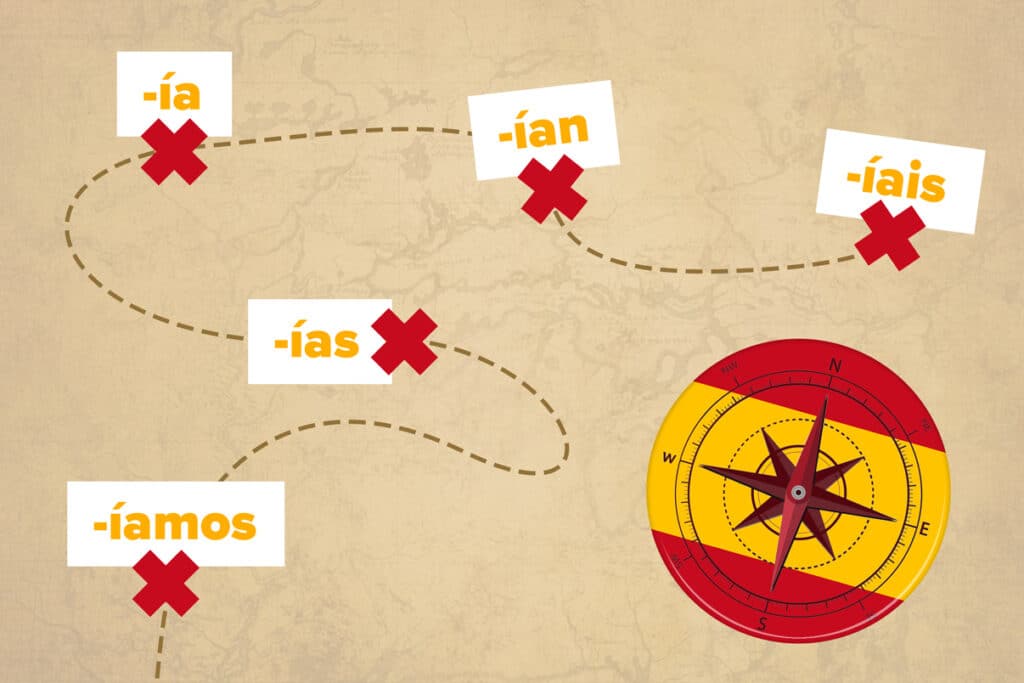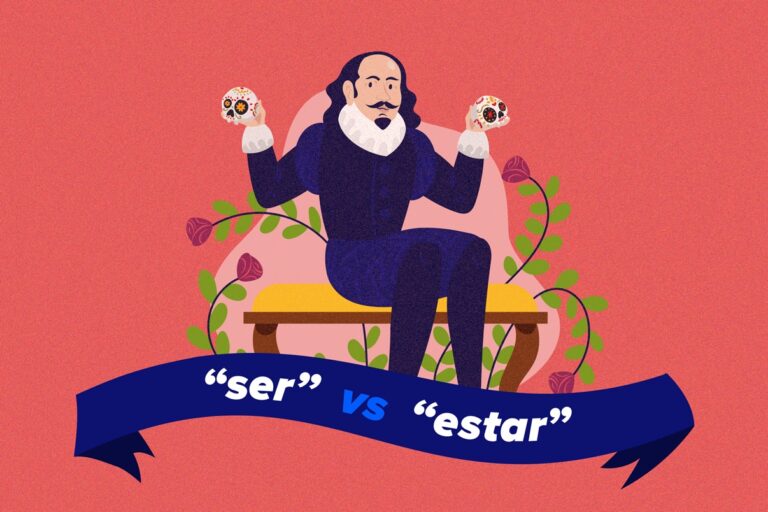Contents
- What is the Spanish Conditional Tense?
- How to Conjugate the Spanish Conditional
- Uses of the Spanish Conditional Tense
- 1. Express the Future in the Past
- 2. Speculate About the Past
- 3. Make Polite Requests or Suggestions
- 4. Make Hypothetical Statements
- 5. Talk About Events That Might or Might Not Occur
- 6. Ask for Advice
- 7. Talk About What Would Be Done in a Situation
- 8. Talk About Things That Probably Won’t Happen
- 9. Express the Probability of a Situation That Has Already Happened
- 10. Talk About Actions That Would Have Happened but Didn’t
- Types of Spanish Conditionals
- And One More Thing…
How to Form and Use the Spanish Conditional Tense

How much time do you spend talking about things that could have happened, or things that could still happen in the future? Whether it’s in English or Spanish, we use the conditional tense for these situations.
Below we will show you everything you need to know about the conditional tense in Spanish. Specifically, we’re going to talk about what it is, how it’s conjugated, how it’s used and the four types of Spanish conditionals you should be aware of.
Download: This blog post is available as a convenient and portable PDF that you can take anywhere. Click here to get a copy. (Download)
What is the Spanish Conditional Tense?
Spanish conditionals are used to talk about hypothetical things—things that could be, could have been or would have happened. They’re typically formed by adding the endings -ía, -ías, -ía, -íamos, -íais or -ían to the infinitive form of a verb.
Think of the entire conditional tense as the English equivalent of “could’ve,” “should’ve” or “would’ve.” For example:
If I had a remote job, I would travel the world.
You shouldn’t go out tonight.
In Spanish, there are two conditional tenses: simple conditional and conditional perfect.
The simple conditional is what most people mean when they talk about the “conditional” tense. It typically applies to things that could happen now or in the future. For example:
Viajaría a Japón.
(I would travel to Japan.)
¿Podrías ayudarme?
(Could you help me?)
Then we have the conditional perfect, which is used to say “would have.” Here are some examples of the conditional perfect:
Habría llegado en Chile a las 8 si mi vuelo no retrasó.
(I would have arrived in Chile at 8 if my flight wasn’t delayed.)
Ellos habrían venido con nosotros, pero su mamá no los permitió.
(They would have come with us, but their mom wouldn’t let them.)
How to Conjugate the Spanish Conditional
To conjugate the Spanish conditional, just add the endings -ía, -ías, -ía, -íamos, -íais or -ían to the infinitive form of the verb. This applies to both regular and irregular verbs.
All regular verbs in the simple conditional tense (whether they end in -ar, -er or -ir) are conjugated like this:
Spanish Conditional Perfect
To form the conditional perfect, we use the formula:
Simple conditional of haber + past participle of the main verb
Here’s the irregular verb haber (to have) fully conjugated in the simple conditional:
| Subject Pronoun | Haber Conditional Conjugation |
|---|---|
| Yo | habría |
| Tú | habrías |
| Él
Ella Usted | habría |
| Nosotros
Nosotras | habríamos |
| Vosotros
Vosotras | habríais |
| Ellos
Ellas Ustedes | habrían |
Next, you’ll need the past participle. This is formed by taking the verb’s stem and adding -ado for -ar verbs and adding -ido for -er and -ir verbs.
Using our example verbs above, their past participle conjugations for all of their corresponding subject pronouns would be:
| Type of Verb | Infinitive Form | Stem | Past Participle Form |
|---|---|---|---|
| -ar | hablar
(to speak/talk) | habl- | hablado
(spoken/talked) |
| -er | comer
(to eat) | com- | comido
(eaten) |
| -ir | escribir
(to write) | escrib- | escrito
(written) |
For more examples of past participle verbs and their conjugations, check out this post:
Past Participle in Spanish (Forming and Using It) | FluentU Spanish Blog
The past participle in Spanish isn’t just for the perfect tense. It can be used in many forms to express yourself in various ways. As a noun, adjective, adverb…even to…
Irregular Verbs in the Conditional Tense
Conjugating irregular verbs in the conditional tense is a bit different, in that their stems vary slightly from their infinitive form.
Fortunately, there are only a few of these irregular verbs you need to memorize (at least, as far as conditionals are concerned). You’ll also notice that the endings are the same as that of regular verbs, and that the conditional stems are consistent across conjugations. For example, salir (to leave/to go out) uses the stem saldr-, tener (to have) uses the stem tendr- and so on.
Check out the table below:
Uses of the Spanish Conditional Tense
1. Express the Future in the Past
You can use the conditional tense in Spanish to talk about something that happened/was discussed in the past that touched on future possibilities.
Me dijo que se casaría conmigo.
(He told me he would marry me.)
Le dije que eso me haría muy feliz.
(I told him that would make me very happy.)
2. Speculate About the Past
The conditional can also be used to talk about something that may or may not have happened in the past.
Se casarían a las 4 de la tarde.
(They must have gotten married at 4 p.m.)
Esa sería la razón por la que se enamoró de ella.
(That must have been the reason he fell in love with her.)
3. Make Polite Requests or Suggestions
This is pretty self-explanatory! If you want to make your request or suggestion sound more polite, it helps to add the Spanish equivalent of “would” in your request—or, at least, conjugate the verb to get the same message across.
Me gustaría hacer un pedido.
(I would like to place an order.)
Me encantaría pasar un fin de semana romántico en Barcelona.
(I would love to spend a romantic weekend in Barcelona.)
4. Make Hypothetical Statements
The Spanish conditional tense can be used to talk about things that might have happened—were it not for a little wrinkle.
Me casaría contigo, pero antes debo ahorrar.
(I would marry you, but I have to save some money first.)
Viajaríamos a París, pero no podemos.
(We would travel to Paris but we can’t.)
5. Talk About Events That Might or Might Not Occur
You could also use the conditional to just speculate on something, period.
Sería romántico casarse en Madrid.
(It would be romantic to get married in Madrid.)
Ser tu esposa sería maravilloso.
(Being your wife would be wonderful.)
6. Ask for Advice
In this case, you use the conditional to formulate questions along the lines of “What would you do if… ?”
¿Qué harías si te dejara?
(What would you do if he left you?)
¿Qué vestido comprarías para la boda?
(Which dress would you buy for the wedding?)
7. Talk About What Would Be Done in a Situation
This is similar to the last entry, except you’re asking for something in a more direct manner. In other words, you’re basically crafting conditional “Yes/No” questions.
¿Te casarías con él?
(Would you marry him?)
¿Le dirías la verdad sobre tu pasado?
(Would you tell him the truth about your past?)
8. Talk About Things That Probably Won’t Happen
We use the simple conditional along with the imperfect subjunctive to form the second conditional, which we will discuss later.
Si me lo pidiera, me casaría con él.
(If he asked me, I would marry him.)
Si pudiera, le diría la verdad sobre mi pasado.
(If I could, I would tell him the truth about my past.)
As you can see, the simple conditional tense has many uses—perhaps even more than some other tenses! To get familiar with them, you need to use them with native speakers and consume natural Spanish content.
You can do this with an immersion program like FluentU, which lets you watch hundreds of Spanish videos with learning tools.
FluentU takes authentic videos—like music videos, movie trailers, news and inspiring talks—and turns them into personalized language learning lessons.
You can try FluentU for free for 2 weeks. Check out the website or download the iOS app or Android app.
P.S. If you decide to sign up now, you can take advantage of our current sale!

9. Express the Probability of a Situation That Has Already Happened
Here, you’re speculating about the chances of a past event happening (or not happening).
Habría estado muy nervioso cuando le pidió matrimonio.
(He must have been very nervous when he asked her to marry him.)
Seguramente habrían perdido el avión a París.
(They had probably missed the plane to Paris.)
10. Talk About Actions That Would Have Happened but Didn’t
In most cases, this use is directly related to the third conditional, which will be covered in more detail later.
Si hubiéramos tenido dinero, nos habríamos casado el año pasado.
(If we had money, we would have gotten married last year.)
Si no te hubiera querido, no me habría casado contigo.
(If I hadn’t loved you, I wouldn’t have married you.)
Types of Spanish Conditionals
There are two clauses or parts in a conditional sentence: the “if” clause and the main clause.
For example:
Si tuviera mucho tiempo, aprendería los verbos condicionales en español perfectamente.
(If I had a lot of time, I would learn Spanish conditionals perfectly.)
Four different types of conditional sentences are based on this structure. Note that we don’t actually need the conditional tense for all of these types!
Zero Conditional: Si + [Simple Present], [Simple Present]
This conditional uses the present tense to talk about things that are always or usually true.
Si sabes el presente, sabes el condicional cero.
(If you know the present tense, you know the zero conditional.)
Forgotten how to form the present tense? See this post for a recap:
How to Form and Use the Spanish Present Tense | FluentU Spanish Blog
Learn the present tense in Spanish with this in-depth guide for beginners. From regular -ar, -er and -ir Spanish present tense verb conjugations to irregular stem-changing…
First Conditional: Si + [Present Tense], [Future Tense] / [Future Tense] + Si + [Present Tense]
The first conditional is used when discussing how something is possible or likely, assuming that a specific condition is met.
Si llueve mañana, no iré al banco.
(If it rains tomorrow, I won’t go to the bank.)
No iré al banco si llueve mañana.
(I won’t go to the bank if it rains tomorrow.)
Check out this post to brush up on your future tense:
Future Tense in Spanish (Uses, Conjugations and Examples) | FluentU Spanish Blog
Knowing the future tense in Spanish opens up a million new conversational possibilities, like discussing future plans, reported speech and making “if” statements. This…
Second Conditional: Si + [Imperfect Subjunctive], [Conditional]
The second conditional is the tense you use when daydreaming about possibilities that probably won’t happen in real life.
Si tuviera la plata, iría contigo.
(If I had the money, I’d go with you.)
See this guide on the imperfect subjunctive if you need a refresher:
The Spanish Imperfect Subjunctive (Conjugation, Uses and Examples) | FluentU Spanish Blog
The Spanish imperfect subjunctive helps you express opinions, hopes, denials, doubts and hypothetical situations—something you’ll hear and use a lot in Spanish. Click…
Third Conditional: Si + [Past Perfect Subjunctive], [Past Perfect Subjunctive]
The third conditional is used when you want to talk about a situation that did not happen in the past but has imaginary consequences.
Si hubiera sabido, te habría llamado.
(If I had known, I would have called you.)
By the way, the past perfect subjunctive is also called the pluperfect subjunctive—and this post will jog your memory on how to use it:
How to Use the Pluscuamperfecto | FluentU Spanish Blog
The pluscuamperfecto or pluperfect Spanish tense might seem scary, but it’s really not! Study this Spanish tense and learn its conjugations to talk about actions that…
So that’s it! You’ve got everything you need to use the conditional tense in Spanish.
With this skill, you’ll be talking about hypotheticals—whether in the past, present or future!
Download: This blog post is available as a convenient and portable PDF that you can take anywhere. Click here to get a copy. (Download)
And One More Thing…
If you've made it this far that means you probably enjoy learning Spanish with engaging material and will then love FluentU.
Other sites use scripted content. FluentU uses a natural approach that helps you ease into the Spanish language and culture over time. You’ll learn Spanish as it’s actually spoken by real people.
FluentU has a wide variety of videos, as you can see here:

FluentU brings native videos within reach with interactive transcripts. You can tap on any word to look it up instantly. Every definition has examples that have been written to help you understand how the word is used. If you see an interesting word you don’t know, you can add it to a vocab list.

Review a complete interactive transcript under the Dialogue tab, and find words and phrases listed under Vocab.

Learn all the vocabulary in any video with FluentU’s robust learning engine. Swipe left or right to see more examples of the word you’re on.

The best part is that FluentU keeps track of the vocabulary that you’re learning, and gives you extra practice with difficult words. It'll even remind you when it’s time to review what you’ve learned. Every learner has a truly personalized experience, even if they’re learning with the same video.
Start using the FluentU website on your computer or tablet or, better yet, download the FluentU app from the iTunes or Google Play store. Click here to take advantage of our current sale! (Expires at the end of this month.)







